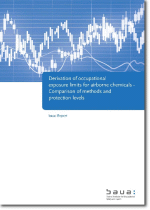- Project number: F 2437
- Institution: Federal Institute for Occupational Safety and Health (BAuA) / Forschungs- und Beratungsinstitut Gefahrstoffe GmbH (FoBiG)
- Status: Completed Project
Description:
The derivation and setting of occupational exposure limit values is an important part of the risk assessment and risk management of chemicals in different national as well as international processes. At EU level, the harmonisation of airborne limit values is a current Issue, because for some substances different limit values for workplaces were yielded by occupational safety and health legislation on the one hand and by chemicals legislation on the other hand.
The overall objective of the project was thus to create a common understanding of the necessary specifications for setting limit values as well as a basis for harmonising the derivation of limit values for the workplace in the EU. Therefore, one part of the project was to disclose the differences between the current methods of limit value derivation and the resulting different levels of protection. The other part was to update and prepare the database for extrapolation factors – i.e. factors that are used in the case of data gaps.
For this purpose
- existing methodological systems were analysed and compared,
- new methodological approaches such as the benchmark procedure and probabilistic procedures were presented,
- suggestions for suitable distributions for extrapolation factors (time, interspecies, intraspecies extrapolation) were made after conducting comprehensive new data evaluations (REACH, NTP, literature),
- and by using these distributions and its combinations the protection achieved by the different derivation methods was made transparent.
The analysis has confirmed that there are methodological differences in the derivation of occupational exposure limit values or analogous values in Germany and at EU level, which can potentially lead to significant quantitative differences between the derived exposure limit values as well as the resulting protection levels. At the same time, an updated, improved empirical database is now available to establish data-based values for extrapolation factors. The project’s results provide the basis for further development and harmonisation of limit value derivations in the EU.
Below, the final report is available. Furthermore, the files used for processing the NTP and REACH data to derive distributions are provided for download.
An international workshop was held at BAuA on 5 April 2022 to present and discuss the results of the project. A written summary of this workshop has been published in the baua: Focus series, and the presentations given there can also be accessed on the BAuA website. In addition, two scientific publications are provided that summarise the project’s most important results (Schneider et al., 2022; Dilger et al., 2022).

